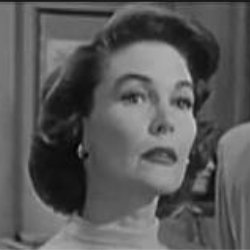
She is probably most memorable for the scene where she scrambles to escape an attempted rape in the library stacks, wrenching in the arms of her attacker and clutching at books which, upset by her grasp, tumble from the shelves. That scene was in Blackboard Jungle (1955) and more than one report says that Margaret Hayes was nominated for an Academy Award for her supporting role in the film. When I asked her son, a broadcast media pro and former child film actor named Rusty Swope,
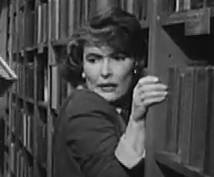
what it was like for his family as the names of the competing nominees were read on Oscar night, he couldn’t quite recall. He thought he remembered that a telegram arrived announcing the nomination and that it might still be framed in some box somewhere – but that was all.
As it turns out, she was never nominated. (Blackboard Jungle was up for four Oscars but Best Supporting Actress was not among those nominations.) The fact that Swope attempted to recall a monumental moment that had never happened isn’t especially surprising when one realizes that the life of his mother, who was often billed as Maggie Hayes, was defined by ambiguities, self-invention, impulse, and compartmentalization.
For instance, there is the account of her bolt from the coal country of Pennsylvania. The first of the handsome brunette’s three marriages came when she was in her 20s in Baltimore, Maryland, to a man named Charles Debuskey. The couple moved to Pottsville, PA., the seat of Schuylkill County. According to Schuylkill Stories – the chronicles of longtime newspaper correspondent and local historian Ione Geier – Charles came home one evening from his job with a local oil company subsidiary, “to discover their baby daughter, Nan, in her high-chair, a chicken roasting in the oven, and his wife gone.” Whether it literally happened that way is left to the imagination. Whether the marriage was a conflagration, a deep freeze, or both is unclear. What is clear to Rusty is that his mother hated life with her first husband – so much so, Rusty says, that part of the divorce agreement was that, “he would get custody of Nan and she would never demand anything or come back to see her again,” freeing Florette Debuskey to ride a swelling wave of professional names (Florette DeBussy, Dana Dale, Dana Edwards, and finally Margaret/Maggie Hayes) in pursuit of her dreams in fashion, film, stage, and television. Though both are living at the time of this writing, Rusty – now a trim senior with the mellow voice of a trained actor – has met his older half-sister only once.
Then, there is the question of how old she was. Maggie was born in Baltimore to homemaker Clara Bussey Ottenheimer and her husband, Jacob Lewis Ottenheimer, an insurance broker and furniture store executive who, in the early days of radio, broadcast a local children’s show for charity: Jack Ottenheimer and His Radio Gang. Her birthname is a cultural hodgepodge: Florette Regina Ottenheimer. The day of her birth was December 5; the year, as cited by diverse sources, varies from 1913 to 1916. The earliest date is the most likely. “They never really told me the truth…about age,” Rusty says of his parents. His father, Margaret’s third husband, was TV and stage producer/director Herbert Bayard Swope, Jr. who was responsible for such early television series as Lights Out. (He was also executive producer of only the first two episodes – notably due to a disagreement with the show’s creator, Max Shulman – of the wildly popular TV series The Many Loves of Dobie Gillis.) “They always said that he was a year older.” Swope now asserts, “My mother was older than my father which I never found out until years later,” though he is not certain how much older. “A year or two, I think.” As we all know, it didn’t behoove an actress of that era to reveal her true age, especially not an actress who was older than her husband by even a slight bit. After Maggie’s passing, the life insurance company penalized Rusty and his sister, actress Tracy Brooks Swope, thousands of dollars because of the difficulty determining their mother’s age.
When I asked Swope what stories his mom told about growing up, about his grandparents and her siblings, he casually answered, “I never knew them.” He said he did meet an aunt whom he referred to as his mother’s, “sister Janice,” and vaguely recalled there was a brother. (Census records from Maryland show that Janice was a slightly younger sister and there was a younger brother, Mose [not Moses], along with an older brother, Lester.) He said she, “didn’t get along,” with her family, hadn’t liked Baltimore any better than Pottsville and, “wanted to get out as soon as possible.” He remembers the only occasion of meeting his grandmother Clara when she came once to visit the Swope family in California, “for a weekend or a week,” as he put it. Rusty reminisced that it was, “like meeting someone who is a stranger and then they go off – still a stranger.”
Early in her show business career, Margaret had a notable romance with screen actor Jeffrey Lynn. This was in her time as Dana Dale (after having tried a spin at modeling in New York as Florette Debussy.) Swope describes that relationship from about a decade before his birth as ending up, “pizzling out.” Drama exploded in 1942 when, finally having settled into the name(s) Margaret/Maggie Hayes, she wedded solid, big-framed actor Leif Erikson. The nuptials came literally just hours after Erikson’s divorce from the ill-fated Frances Farmer became final. That marriage lasted somewhere from nine days to four months, depending on to whom you wish to listen. About that Swope says, as one might expect, “My mother told me nothing except that she was married to him.”
She did tell Rusty about a wild ride with Lorne Greene of Bonanza fame. Swope was an adolescent by the 1961 filming of “The Countess” episode of that series, and old enough to notice that Maggie had developed a little crush on Greene while working on what Swope reports as, “the biggest part they had given a woman on Bonanza,” up to that point. She said that Lorne took her for a spin in his Mercedes one day at speeds that reached around 125 miles an hour, dazing her in her seat.
A close girlfriend in the Pottsville days, who even shared the same December 5 birthday, Sylvia Lappen was a confidant to Hayes’ dreams of an acting career. In Schuylkill Stories, Lappen related, “It’s all she ever talked about when we walked to the synagogue every week for Sunday morning services.” (This was the only reference I encountered to Margaret Hayes having Jewish heritage until further research through the Jewish Museum of Maryland confirmed the Ottenheimer family’s religious persuasion.) “Florette was very attractive,” she goes on to say, “but she felt the shape of her nose was a deterrent to getting anywhere on the stage or in movies. To earn money for plastic surgery, she sold hosiery door-to-door.”
The door-to-door peddling of a clothing accessory would be a natural path for a young person whose first job out of high school had been as a department store window dresser and who would later have a brief modeling career. Though Margaret, at an early point, had entered the Johns Hopkins undergraduate school of medicine, ostensibly with a fugitive eye toward becoming a nurse, the work which ultimately fed her grew from the innate love of fashion and flair that influenced Hayes’ entire life. Her personal style is obvious in the regal bearing she brings to the screen in episodic roles such as the four guest appearances she made on the Perry Mason TV series between 1957 and 1963; or even as the rather overblown Queen Zarada in Hollywood’s telling of the
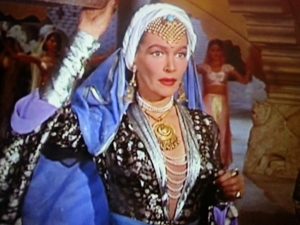
Omar Khayyam story in 1957 in which Khayyam is portrayed by matinee idol Cornell Wilde (seriously?!). Regarding Hayes’ altered appearance, Lappen adds, “I still remember where she had her nose job done. It was Flower [Fifth Avenue] Hospital in New York City.”
Hayes appeared in more than a score of movies in the 1940s and made a plethora of TV appearances in the 50s and 60s in such popular shows as 77 Sunset Strip, Rawhide (which launched the career of Clint Eastwood), The Defenders, and Flipper. She starred in the 1965 soap opera A Time for Us (aka A Flame in the Wind) in which son Rusty also made an appearance. Many actors of Hayes’ generation revered stage work over the screen; but she was not one of them. Rusty shared that, “She really liked the glamour of movies and television.” Treading the boards never worked out well for Margaret. Her first role on Broadway was in a drama titled Bright Rebel at the Lyceum Theatre. It opened December 27, 1938 and closed after 7 performances. More than twenty years later, she appeared in Step on a Crack at the Ethel Barrymore, produced and staged by husband Herbert Swope, Jr. That one opened and closed for good on the same night! Then came a third try, at the Cort Theatre in Fair Game for Lovers. The comedy featured Maggie Hayes, Leo Genn, Forrest Tucker and Alan Alda. It opened February 10, 1964 and closed five nights later. This promising but unfortunate flop was, too, produced by husband Swope.
Maggie met Herbert Bayard Swope, Jr. in the late 1940s at a party in the New York home of playwright George S. Kaufman. This is where and when the intertwinement of their lives – both personally and professionally – began. That suffix “Jr.” is significant in the story of Maggie and Herbert. “Senior” was a famous, 3-time Pulitzer Prize-winning journalist – as noted for his celebrity associations and Gatsby-like mansion as he was for his brilliance as a reporter, and his innovations as an editor. “My mother was very into climbing the social ladder,” Rusty says; Rusty’s birthname is Herbert Bayard Swope III, carrying the socially prominent moniker on into a third generation. The son of an upper crust figure such as Swope, Sr. had to be magnetic for Maggie. But Rusty immediately qualifies his statement, adding, “They fell in love.” (At one point, his dad sported an eye-catching red goatee.) “They were married for 26 years and then after 26 years decided to get a divorce, which was just,” pause, “like…,” he finally decides just to say, “why?” This is a question for which he actually knows some of the answers, for example: the eroding effect of his father’s squandering and infidelities…
Margaret’s celebrated father-in-law was known for, among things already mentioned, his gambling. It is easy to confuse a certain mansion on the Long Island Sound, in Great Neck, NY with Swope Sr.’s nearby estate: Land’s End Sands Point. According to Rusty, the Great Neck home was the one whose legendary parties inspired F. Scott Fitzgerald in writing The Great Gatsby. His grandfather owned the Great Neck mansion first, “and then when he moved to Sands Point, the parties kept going.” Surely Margaret must have frolicked at one or both, but Rusty’s memories of two childhood summers at Land’s End are all his own. “You could walk in there at 5:00 in the morning, there was always somebody on staff. You could sit down, like at a diner, and order…whatever you wanted. If you wanted a steak dinner, you could get that.” Rusty was way too young to carouse with the adults but later found accounting books which revealed that huge sums of money were won – and lost – in poker games. “Herbie, my father,” he says, misspent a lot of his money, “on wild lifestyle,” and, unlike Rusty’s grandfather, his pockets could not afford the outpour. This was clearly a contributing factor to Maggie and Herbert’s divorce. (Land’s End Sands Point met the sad fate of
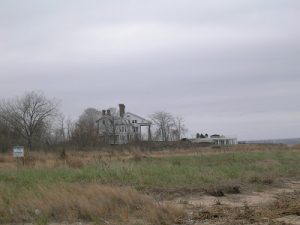
being sold by Margaret Hayes’ mother-in-law to meet the ailing widow’s mounting medical expenses after Swope, Sr.’s death. According to young Swope, the buyer pretended to purchase the estate out of reverence, intending to restore it to glory; in reality, he was a developer who divided up the land and sold the pieces for an obscene amount of profit. The neglected, crumbling mansion itself was razed in 2011. When asked if that broke his heart, Rusty says, “It did.”)
There was a less imposing house that left a strong memory for Margaret’s son. Back in the Blackboard Jungle filming days, the family was renting an attractive house in Beverly Hills and remained in it for a while after filming ended. 730 North Bedford Drive would soon become a homicide scene. A year or two after Hayes’ family moved out, the teenaged daughter of movie star Lana Turner, in an upstairs bedroom, stabbed Turner’s ill-reputed boyfriend to death.
The 26-year long Hayes-Swope marriage, and Maggie’s career in entertainment, ended less suddenly.
“She was a great mom,” Rusty says, advancing that this is something important he would like people to know and remember about his mother. But his intonation is circumflex, as if there is some qualification to follow. “I mean, I remember her taking care of us a lot,” pause, “but I also remember that business sort of came first. You know? I remember her going out a lot at night.” Nighttime socializing in Hollywood’s late Golden Era was often vital to promoting, or sustaining, a show business career. “I used to cry, ‘Don’t go out; stay home with me,’” that sort of thing. “But she’d go anyway. She was really driven, much more than my father…They both really cared about themselves and their careers, which was hard. The career was first.”
With Margaret’s husband, love affairs apparently came second. “He was cheating on her,” a condition, the son maintains, “which went on, I think, the whole marriage,” adding for emphasis, “with whoever was near.” (The only affair Rusty sited specifically was one with a beautiful Italian actress with lush, red hair and an extensive body of work in TV and film. He named her. But as she is, at the time of this writing, long-married and in her 80s, I have chosen not to.) Swope’s firing from Dobie Gillis didn’t help the health of the marriage either; nor did the couple’s having two Broadway flops together in quick succession. “My mother was essentially supporting my father,” Rusty says. “Then the wars started.”
Some biographical accounts state that Margaret spent a brief period, mid-century, as fashion editor at Life magazine, and a four-year gap in her television credits indicates that this is probably accurate. She wrote a book, co-authored by Alfred Allan Lewis and published in 1972: Maggie 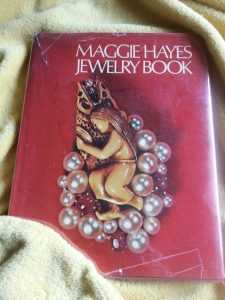 Hayes Jewelry Book. An elaborate brooch consisting of an ivory-carved mermaid sleeping on a salmon of intricate design is pictured on the cover; they rest in a nest of pearls of varied sizes and smooth, polished rubies, and the salmon holds some of the jewels in its mouth. The book is lavished with black & white shots of Maggie’s manicured hands, deft in such crafts as wax molding, and using tweezers to set stones in striking arrangements to create bold necklaces, bracelets, brooches and earrings. “She really did like jewelry design,” Rusty affirms. “She loved it and she got a contract with Bergdorf Goodman and had a counter there. The jewelry business was bringing her enjoyment and money,” he goes on, “and she was traveling a lot to different places…It took her around the world. I think she enjoyed that part, especially since she wasn’t getting along with my father. And I think he was lost. I don’t think he knew what to do.”
Hayes Jewelry Book. An elaborate brooch consisting of an ivory-carved mermaid sleeping on a salmon of intricate design is pictured on the cover; they rest in a nest of pearls of varied sizes and smooth, polished rubies, and the salmon holds some of the jewels in its mouth. The book is lavished with black & white shots of Maggie’s manicured hands, deft in such crafts as wax molding, and using tweezers to set stones in striking arrangements to create bold necklaces, bracelets, brooches and earrings. “She really did like jewelry design,” Rusty affirms. “She loved it and she got a contract with Bergdorf Goodman and had a counter there. The jewelry business was bringing her enjoyment and money,” he goes on, “and she was traveling a lot to different places…It took her around the world. I think she enjoyed that part, especially since she wasn’t getting along with my father. And I think he was lost. I don’t think he knew what to do.”
Taking her jewelry design business to Florida, Maggie opened a shop in posh Palm Beach. The Swopes divorced in 1973. “In the end, he kept going to Palm Beach,” Rusty says of his father. Despite her growing ill with cancer, Margaret arranged jobs for Herbert, doing local radio and television reviews for the Royal Poinciana Playhouse which presented plays packaged with major celebrity actors. “She was good to him. She loved him,” Rusty repeats, though, of the marriage – and the entertainment industry – he analyzes, “I think she had just had it.”
Margaret passed away in Palm Beach in 1977 with her son by her side. “She died really young,” Rusty says. “She was 63 when she died,” and adds that he is assessing. “I think that was her TRUE age.”
In Schuylkill Stories, journalist Geier muses on Hayes’ starring role in Appointment in Samarra. This was her husband’s 1953 television production of an installment of the Robert Montgomery Presents anthology series – an adaptation of John O’Hara’s novel about monied society in his hometown of Pottsville, PA, “the very place she had run away from when she was still Florette Debuskey,” Geier remarks. “Did it give her a certain satisfaction to play the upper-class Caroline English, whose social status in Appointment in Samarra was so different from her own more modest beginnings? Did performing in a dramatization of a book about the town where she had once lived arouse regrets…?” These are some of many misty musings about Margaret/Maggie/Dana/Florette – a life that leaves, perhaps, more questions than answers.
Special thanks to Joanna Church, collections manager of the Jewish Museum of Maryland and to Becki White, MLS, reference librarian of the Pottsville Free Public Library
<- Return to search